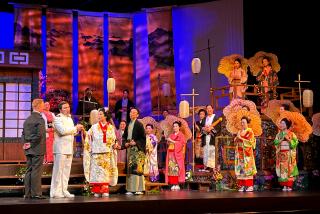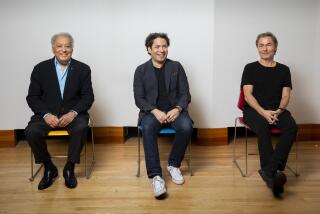CURRIE LEADS L.A. MASTER CHORALE
It seemed a bit pretentious to call the Los Angeles Master Chorale’s Sunday program a “Beethoven Festival.” But music director John Currie certainly took a big, bright, festive view of four middle-period works, to the obvious delight of the audience at the Music Center Pavilion.
Currie’s approach to the Mass in C was well within standard big-chorus parameters, with scant deference to period style. He infused the more jubilant moments--particularly the ends of the Gloria and Credo movements--with explosive energy of great emotional thrust.
But in introspective passages--most notably those involving the soloists--he allowed the spiritual level to flatten out into prosaic note-reading. Currie proved an uncommonly head-down, score-bound conductor Sunday, turning to routine time-keeping when the music most demanded poetry.
The chorale gave Currie a wide dynamic range to work with, although he insisted on truly soft singing only in the Sanctus. The singers sounded well drilled, although balances in homophonic passages consistently slighted the middle parts.
In the incidental solos, mezzo Janet Smith easily dominated soprano Mary Rawcliffe, tenor Thomas Randle and baritone Thomas Wilcox in sheer vocal weight. Despite that, the ensembles were fluent and well balanced. Would that Currie had made more of the “Et incarnatus est”!
The Choral Fantasy, however, was the scene of the greatest solo heroism. Zita Carno, the L.A. Philharmonic’s preternaturally versatile pianist, substituted on very short notice for the reportedly ill Michael Zearott. Under the circumstances, her handling of the extensive, demanding solo part proved remarkably adroit and musically sensitive.
The Fantasy sounds very much like out-takes from the finale of the Ninth Symphony, the pianist replacing the baritone soloist at the beginning. Currie maintained a suitably buoyant spirit.
“Meeresstile und Glueckliche Fahrt’ is a large choral song on texts by Goethe. Currie took the first section slightly too loud and too fast, reducing the still terrors of the text to an eager anticipation of the joyful dash to shore. That, at least, was wonderfully alive in both sense and sound.
The supporting Sinfonia orchestra turned out typically stalwart accompaniments, occasionally sounding rough in woodwind solos and ensemble matters but usually polished and alert. Currie gave it the opening bow, with an undramatic reading of the “Egmont” Overture.
More to Read
The biggest entertainment stories
Get our big stories about Hollywood, film, television, music, arts, culture and more right in your inbox as soon as they publish.
You may occasionally receive promotional content from the Los Angeles Times.










